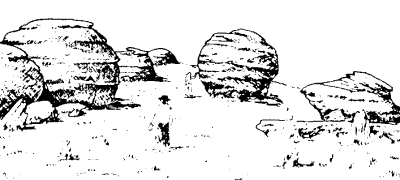 |
Science Frontiers ONLINE No. 127: Jan-Feb 2000 |
|
|
Natural Stone Spheres
Whenever we see nearly perfectly wrought stone spheres in natural settings, we usually jump to the conclusion that they have been shaped by human hands. We assume that natural forces are too erratic to sculpt such neat geometrical solids. This stance is sometimes justified, as confirmed by the hundreds of precisely executed stone spheres found in the jungles of Costa Rica. Nature herself, however, is often an expert craftswoman. Some concretions are beautifically spherical, so are some spheres fashioned in volcanic calderas. In Utah, though, southeast of Cleveland, in a formation called the Molen Reef, there are literally millions of stone spheres of more mysterious origin. E. Hansen described these in a recent issue of the Ancient American.
"The spheres range in size from as small as a baseball to over 10 feet in diameter. The bigger ones are more perfectly round than smaller examples. After a lifetime of trying to form a theory of how these were formed, I can only throw up my hands in surrender! They are clearly formed as mud on a lake bottom, because when two touch, one will indent the other, or both will be equally distorted. The mud simply hardened over time into sandstone."
(Hansen, Evan; "Stone Spheres of the American West," Ancient American, no. 29, p. 31, 1999.)
Comment. Smaller lithified "mudballs" (usually under 1-foot diameter) have been reported from many geological formations worldwide. (See ESA2-X3 in Neglected Geological Anomalies.) The Costa Rican human-fashioned stone spheres are cataloged in MSO2 in our just-published Ancient Infrastructure.
 | Large, calcareous, spherical concretions create a "rock city" in Kansas. (From: Neglected Geological Anomalies). |